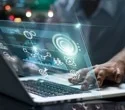When the skull is smaller than usual or misshapen , it presses on the brain and forces it downwards into the spinal canal is known as a Chiari malformation. It typically affects the region of the brain called the cerebellum, which is responsible for controlling balance.
In most cases of Chiari malformation, it is present at birth. However, in some types , the symptoms develop later in childhood. Based on the severity, the patient may need regular monitoring.
The blog explains the Chiari malformation, its types, causes, symptoms, and various treatment options.
What is Arnold-Chiari malformation?
In the 1980s, Hans Chiari, an Austrian pathologist, first described this brain abnormality. Therefore, the condition was named after him.
Chiari malformation type 1 occurs when a section of the skull having a part of the cerebellum (brain) is deformed or is too small, thus crowding or putting pressure on the brain. The lower part of cerebellum is displaced into the upper spinal canal.
Chiari malformation type 2 is nearly always linked to a form of spina bifida known as myelomeningocele.
As mentioned, the disorder is most often genetic. It can cause neurological symptoms, including loss of balance.
It is also known as Arnold-Chiari malformation, hindbrain herniation, and tonsillar ectopia.
What are the types of Arnold Chiari Malformation?
Experts have noted four types of Chiari malformation. They are as mentioned below:
- Chiari Type 1: the most common form of Chiari malformation in children. Patients with this disorder do not show symptoms or develop symptoms during adolescence or adulthood. It affects the lower part of the cerebellum and not the brain stem. The cerebellum enters into a hole at the base of the brain known as the foramen magnum. Usually, the spinal cord passes through this passage. It is often accidentally found during the diagnosis of other health conditions.
- Chiari Type 2 : typically develops in patients with severe Spina Bifida, known as myelomeningocele. It occurs in utero when the spinal cord and backbone do not correctly close before the child’s birth. Surgery is necessary soon after birth to close the spinal cord and the backbone, and the chances of paralysis are high. Chiari type 2 affects both the cerebellar and brain stem tissues, Chiari Type 2 is also known as classic Chiari Malformation or Arnold-Chiari malformation.
- Chiari Malformation Type 3: It is rare and severe form of a Chiari malformation. In this, the cerebellum or the brain stem enters the spinal cord through an opening in the back of the skull – known as the foramen magnum. The abnormality leads to swelling at the back of the skull, known as encephalocele. Type 3 causes life-threatening complications and neurological symptoms, including learning delays and seizures. Patients with Chiari malformation type 3 may also suffer from hydrocephalus – the accumulation of cerebrospinal fluid in the brain. Typically, doctors diagnose this form of Chiari malformation during pregnancy through ultrasound or at birth.
- Chiari malformation type 4: A rarity where the cerebellum is underdeveloped or certain parts are missing. However, the spinal cord and the skull are exposed . This type is severe and causes fatality.
- Chiari malformation type 0: This form is controversial to some experts as there is little to no protrusion of the cerebellum into the foramen magnum. It is the rarest form of Chiari malformation. However, doctors may find significant crowding, causing abnormal cerebrospinal fluid flow at the base of the skull.
What are the causes of Chiari malformation?
Several causes lead to Chiari malformation. Some of them are as follows:
- Structural defect: It occurs when the baby is developing in the uterus. Certain researchers believe that when the skull is smaller than the standard size can lead to crowding and increased pressure on the brain, thus pushing the tissues through the foramen magnum, where the brain and the spinal cord meet.
- Genetics: A family history of Chiari malformation can increase the risk of a person developing the same, as it may be inherited.
- Lack of nutrients: Some experts believe that lack of some nutrients during pregnancy may also play a crucial role.
- Infections and high fever: During pregnancy, if the pregnant woman develops an infection or high fever, it may affect fetal development.
- Exposure to toxic chemicals: illegal substances, alcohol, and toxic chemical are harmful during fetal development.
- Other factors: Chiari malformations are mostly present at birth, and symptoms often develop later in life.
In some cases of Chiari Malformation, it can occur due to accidents or infections where the spinal fluid is drained out, known as secondary Chiari malformation.
What are the symptoms of Chiari malformation?
Every person’s symptoms vary from each other. Some may experience mild symptoms, while others develop severe symptoms. Some symptoms present at birth, while others may appear in late childhood or adulthood. Some of the common symptoms are as follows:
- Headache: It is a common symptom. Headache may start or worsen after the person coughs, sneezes, or strains, often developing at the back of the head. However, the ache may spread to the neck and shoulder. Patients describe the pain as throbbing, stabbing, or sharp.
- Balance and movement issues: Chiari malformation may cause weakness in the muscles, lack of coordination, and numbness in the limbs, causing a lack of fine motor skills. It can also result in dizziness, vertigo, and balance issues.
- Issues in hearing and vision: Some patients experience buzzing or ringing sounds in the ear and have trouble hearing. They also experience double vision, blurred vision, abnormal eye movements, and sensitivity to light.
- Problems with eating, drinking and speaking: Swallowing becomes difficult. Some babies with Chiari malformation may experience vomiting, gagging, or drooling, in addition to difficulty eating and may struggle to put on weight for proper development.
- Scoliosis: Curvature of the spine, known as scoliosis, is seen in some people with Chiari malformation.
- Sleep-related issues: Patients may also experience insomnia due to headaches, while others may also experience sleep apnea.
- Problems with bladder and bowel: Chiari malformation may also cause bladder and bowel control issues.
- Other symptoms: Chronic fatigue, palpitations, fainting spells, and tingling or burning sensations in the fingers, toes, or lips are some of the other symptoms.
Irrespective of the type or severity of the condition, the following are the symptoms in an infant:
- Problems swallowing
- Excessive drooling, gagging, or vomiting
- Irritability while eating or feeding
- Breathing difficulties
- Developmental delays
- Stiff neck
- Problems gaining weight
- Lack of arm strength
If the infant is suffering from Chiari malformation type 2 with excess fluid in the brain, the following are some of the additional symptoms to look out for:
- A large head
- Vomiting
- Seizures
- Irritability
- Delay in development
If the symptoms are developed rapidly, they may require emergency treatment.
Who is at risk of developing Chiari malformation?
Chiari malformation affects anyone. However, women are more likely to develop this than men. Babies may be born with this condition, but it may not be discoverable until their teen years or adulthood. The disease is incurable, but the symptoms are manageable with constant monitoring, medications, and, sometimes, surgery.
Patients with other neurological and bone conditions also are at a higher risk of developing Chiari malformation. They include the following:
- Myelomeningocele: A severe spina bifida where the spinal canal and backbone do not close before the baby’s birth.
- Hydrocephalus: When there is an accumulation of excess fluid in the brain, mostly seen with Chiari malformation type 2 patients.
- Syringomyelia: Patients have a cyst in the spinal column called a syrinx
- Tethered cord syndrome: A disorder where the spinal cord gets attached to the spinal bone causing damage to the lower body. Patients with myelomeningocele are at higher risk of developing this syndrome.
- Spinal curvature is a common condition among patients with Chiari malformation type 1.
When to seek medical help?
If a person or a child experiences symptoms that can be associated with the disease, seeking medical evaluation is necessary. Sometimes symptoms are similar to other disorders, and only a medical practitioner can diagnose the condition correctly.






